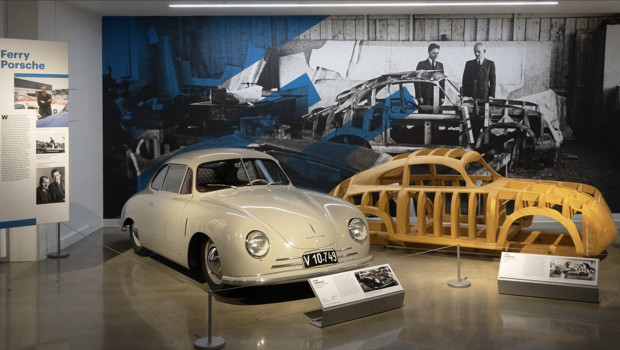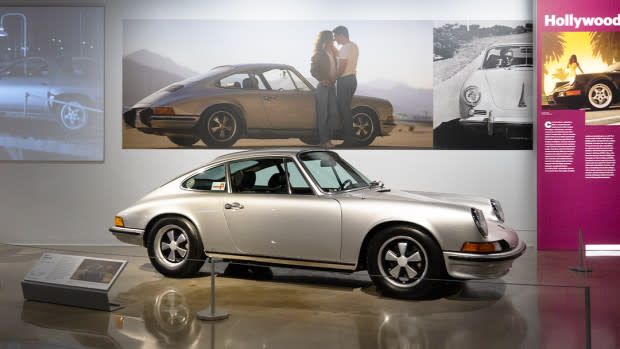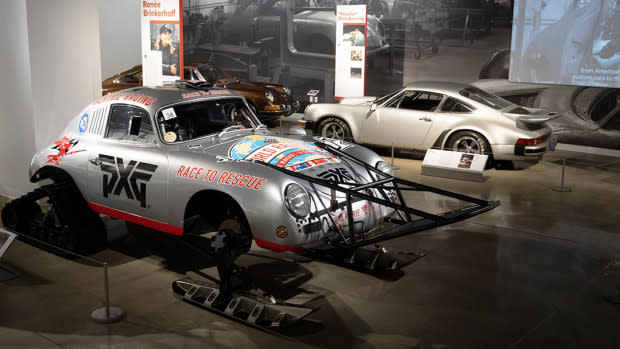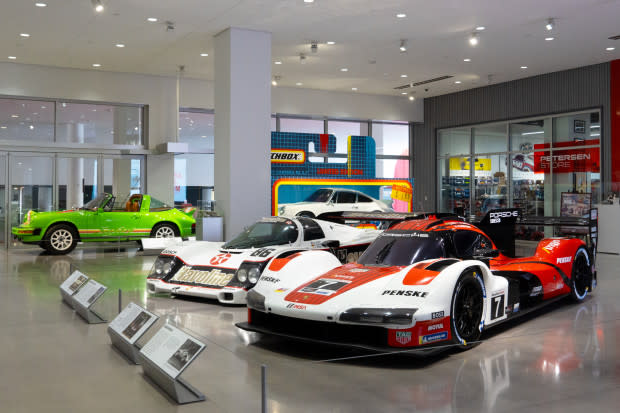Porsche Exhibit at Petersen Automotive Museum Honors the Best of the Brand’s Fabled 75-year History
- Oops!Something went wrong.Please try again later.
An expansive new exhibit at the Petersen Automotive Museum gathers together a once-in-a-lifetime group of Porsches to celebrate the marque’s 75th anniversary. Entitled “We are Porsche,” the show features over 40 cars running the gamut from the first Gmünd coupe through F1, IMSA, and LMDh motorsports, and up to current times, supported by Hollywood stardom and custom culture all the while.
In the modern era, consumers may well know the Cayenne, Macan, and Panamera commuter cars better than Porsches of old, but collector and enthusiast engagement has continued to boost classic values—from the flagship 911 all the way down to formerly maligned models like 914 and 924. At the Petersen, understanding the history that Porsche has imbued in every current make and model only contributes to a legend that started three quarters of a century earlier.

Michael Teo Van Runkle
A Hero’s Origin Story
Porsche’s history began like so many classic origin stories—when a humble automotive engineer decided to build his own dream car after he couldn’t find an appealing enough one for sale. Of course, Ferdinand Porsche had already designed “The People’s Car” (aka the Volkswagen Beetle), so his first attempts at producing a more performance-focused sports car naturally followed the same recipe: a rear-mounted, air-cooled engine; torsion bar suspension; and a simple interior with reliable components.
At Petersen, Porsche history reaches back as far as the earliest hand-hammered aluminum bodies, formed on wooden bucks at a makeshift factory in Gmünd, Austria, through 1949. Estimates place the full run of 356 coupes and cabriolets from Gmünd at only 52 cars total, with the aluminum bodies draped over steel tubs and powered by early 1.1-liter flat-four engines that maxed out at around 40 horsepower and 87 miles per hour.
Related: Acura NSX: A Supercar Steal
Porsche then relocated to a factory in Germany, where steel bodies replaced aluminum to vastly improve the ease of production—while the 356’s combination of lighter weight, nimble handling, and sufficient (if not overwhelming) power soon drew attention from the racing world. Not only would privateers begin hot-rodding their Porches, but the factory soon delved into motorsports, too.
By 1953, Ken Miles and Betty Shutes raced a 550 Spyder, while Porsche’s first and only Formula 1 racecar, the open-wheeled 804, claimed two wins in 1962 with Dan Gurney behind the wheel. Both are on display at Petersen, as are a 917/30 Can-Am Spyder driven by Mark Donohue and a Brundage/Brumos 911 2.8 RSR piloted by Peter Gregg and Hurley Haywood to IMSA and Trans Am championships.
Nearby sits a 2019 Porsche 935, the modern track-only variant that Jeff Zwart took to the Pikes Peak International Hill Climb in 2020, bedecked in heritage-inspired livery. Downstairs in Petersen’s lobby, the current pinnacle of Porsche’s racing heritage greets guests: a 963 developed for the new LMDh class that combines regulations for Le Mans and Daytona prototype endurance racing.

Michael Teo Van Runkle
Porsche as Celebrity
Many overlaps between motorsport and Hollywood superstardom over the years often somehow involved Porsche, too. Famous racing-obsessed actors who drove Porsches include Steve McQueen, whose 1976 911 Turbo can be spotted at the Petersen alongside Patrick Dempsey’s 2014 911 GT America in as-raced condition.
Directly across from that display sits the 1973 911S that Jennifer Connelly drove to visit Tom Cruise at the tail end of Top Gun: Maverick. A small placard nearby serves as a reminder that in the original Top Gun, Kelly McGillis also drove a 1958 356 Speedster (though the car actually used for filming was a replica).
Related: First Look: 2023 Porsche 911 GT3 RS
Other famous names and cars include actor Daniel Wu’s 1988 911 Carrera, purchased new by his father in a rare Cassis Red paint that Wu picked out at only 13 years of age. Guns N’ Roses guitarist Slash also contributed a 911 Turbo to the display. And a relatively unknown project recently paired Porsche with Lucasfilm to produce the Tri-wing S91X Pegasus Starfighter that appeared in the 2022 TV series Obi-Wan Kenobi.

Michael Teo Van Runkle
Custom Culture from the Get-go
Since the earliest days of Porsche’s factory and privateer motorsport history, racers and hot-rodders began customizing the little cars from Stuttgart to improve both style and performance. Each attempt can either highlight or detract from the attributes that make Porsche so unique, but some of the best are included in “We are Porsche.”
Perhaps the most famous is Rod Emory’s 1998 build, which started with a 1964 356 Cab that Emory then smoothed out over a tubular space frame to lend lines more closely related to a 550. A 964-generation 911 with a shortened camshaft housing now pumps out 220 horsepower, which should make the little now-coupe quite a screamer.
Related: Six Classic Cars That Will Grow in Value
Other projects include a four-door 1967 911S by Troutman and Barnes, a 1976 911 “RSR” built by Chris Banning as a pure Mulholland Drive king of the mountain, and even a snow-prepped 356 driven by Renee Brinkerhoff on every continent (including Antarctica) as part of a global effort to raise money that can help end child trafficking.

Michael Teo Van Runkle
Future Is More than an Attitude
Throughout the Petersen exhibit, multiple art cars further highlight the design and engineering that made Porsche so special all along. From a psychedelic Boxster to an eye-popping Safari 911 and even a 911 Carrera RS 2.7 wrapped up as a full-size Matchbox toy, the show provides a glimpse at every aspect of the community that makes the show’s title so apt.
Meanwhile, the 918 Spyder’s hybrid architecture hints at the future for Stuttgart’s latest and greatest. Perhaps the greatest surprise of all when visiting “We are Porsche” is the lack of a Taycan as indication of the big shift underway at Porsche, given that the 718 and Macan are destined to switch to fully electric power for the next generation.
The sales successes of the original Boxster, the first Cayenne SUV, its Macan sibling, the Panamera four-door, and first Taycan EV have significantly expanded the number of owners who can say, “We are Porsche” now. But as the exhibit demonstrates, the ability to lead an industry into the future while retaining the distinctive nature of unique cars have fit into the Porsche picture from the get-go.
“We are Porsche” is open to the public now through April 2024.

